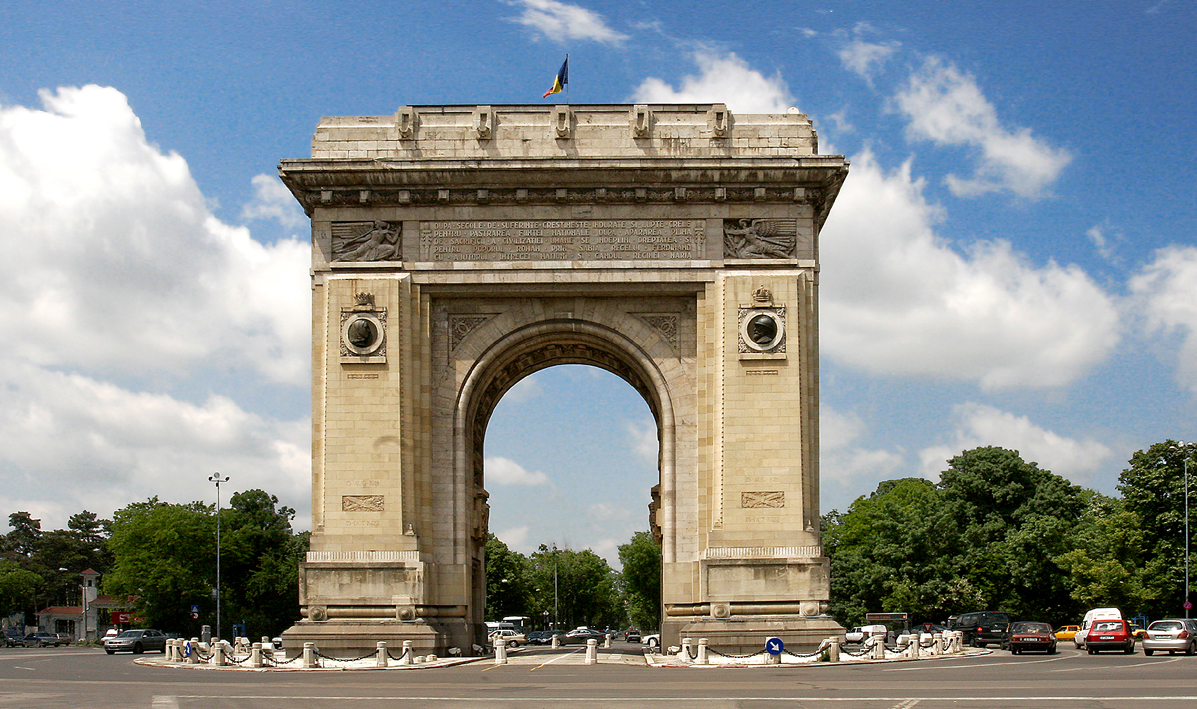
Romania is a country located in Southern Europe, in the North of the Balkan Peninsula.
It has an area of 238,391 km2 and the borders are: Ukraine to the north and east; the Black Sea and Moldavia to the east; Bulgaria to the south; Serbia and Hungary from south-west to west.
There is evidence that Romania has been inhabited since about 40,000 years ago. A first proof of this is the discovery of the cave with bones in the region of Banat, where the remains of Europe's oldest modern man (35,000-40,500 years ago) were found.
Romania has a tricolor flag which has colors arranged in vertical strips of equal size in the following order: blue, yellow, red and it dates of the first half of the nineteenth century. Each color is considered a symbol. Thus, blue is associated with the notion of "Liberty" (blue sky), the yellow of "Justice" (yellow of the fields) and red is associated with the word "fraternity" (red blood).
The Romanian national currency is the "leu" (plural "lei"), which has the subdivision the "ban".
Romania is considered a country of the Danubian-Pontic Carpathians because it has shaped the territory according to the form of the Carpathians and is located on the bottom of the Danube which has the exit to the Black Sea.
The relief of Romania is harmoniously distributed. Thus, the mountains occupy 31%, the hills and plateaus 33% and the palines 36%.
The climate is continental temperate and has slight external influences (Oceanic and Mediterranean). This type of climate creates the 4 seasons: spring, summer, autumn and winter. The average annual temperatures exceed 11 ° C in the south and fall below 0 ° C on the highest peaks.
In 2016, according to the National Institute of Statistics, Romania had a population of 22,241,718 inhabitants. It is composed of Romanians (89.5%), Hungarians (7.1%), Romms (1.75%), the rest are Germans, Ukrainians, Russians, Turks, Lipovans, Tartars.
Among the most popular tourist attractions in Romania are: Bran Castle, also known as "Dracula Castle", Transfagarasan and Transalpina Roads, Corvin-Huniazilor Castle, the medieval city of Sighisoara. In addition, in Romania there are other areas with high tourism potential.
The capital of Romania, Bucharest, is the largest industrial center of the country. Also known as "Petit Paris", is one of the main tourist centers of Romania. Here, we find many sites of historical interest, which impress, combining all the architectural styles: the Romanian Athenaeum, the Village Museum, the Arch of Triumph, the National Museum of Art of Romania, Natural History museum "Grigore Antipa", National History Museum, Botanical Garden, Stavropoleos Church, Manuc House (Hanul lui Manuc). The most important tourist attraction is the Parliament Palace in Bucharest or the House of People, which is the second largest building in the world after the Pentagon and it has six thousand rooms.
Another region with high tourism potential is Maramures (in the north-west), with unique folk and ethnographic values in the country. The main points of interest in this area are: the Merry Cemetery, wooden churches - unique in the world, the Sighet Memorial which has been named by the Council of Europe among the top three places of European culture of memorials, alongside the memorial in Auschwitz and the one of Peace in Normandy.
One of the most important objectives of Romania is the Danube Delta, the second largest delta in Europe and the best preserved of the European deltas.
The Carpathian mountains also attract many travel programs: hiking trails, tourist circuits, speoturism, rural tourism. Also, there are a large number of ski resorts.
The region of Bucovina (in the north-east) is highly sought after in tourism, rich in churches, with unique frescoes, which are inscribed in UNESCO and are considered as true monuments of feudal art. There are also in Transylvania a large number of fortified churches still in UNESCO's heritage, including Viscri and Biertran.
Another representative city is Constanta, the largest port on the Black Sea and the second largest in Europe after Rotterdam.
Romania is a country where beauty blends harmoniously with ancient customs and local traditions.
Redaction: Gabriela Mihai by Arttour Romania
